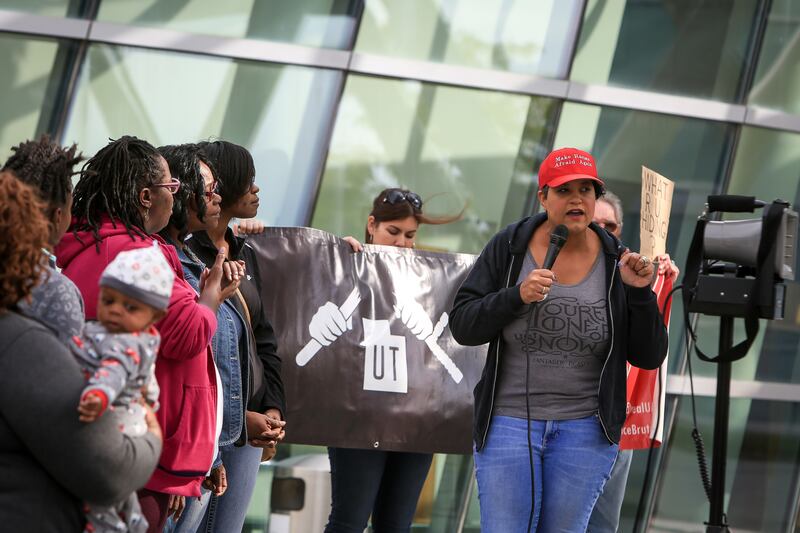SALT LAKE CITY — Two days after a protest turned violent in Salt Lake City on May 30, Lex Scott headed to the streets of the city. It was a Monday evening, and the head of Black Lives Matter Utah had a message for protesters:
“When they do violence, it comes back on Black Lives Matter, and I’m not having it tonight,” she told our reporter, Jeff Parrott, pausing from her interaction with protesters “I just did eight hours of damage control for the last protest when I’ve been working for six years for police reform.”
The interview became part of a Deseret News video that chronicled the second of what would be a month of nightly protests in Salt Lake City and other parts of Utah. That May 30 protest resulted in the eventual arrest of nine people in connection with overturning a police car that was eventually torched. That had nothing to do with Black Lives Matter Utah, and Lex Scott needed the public to understand that violence hurts the cause of police reform.
In fact, since the start of the protest movement, Black Lives Matter has officially only organized two of the protests.
Exactly four weeks later, wearing a cap from the University of Utah, her alma mater, Scott settled in front of her computer readying for a Zoom call in front of the editorial boards of the Deseret News and KSL.
We invited Scott to share her thoughts on racism, the Black Lives Matter Movement, the media (including the Deseret News and KSL), protests and the goals that she has been working on for years.
Here’s the thing. Since she began this effort we had never invited her before the editorial board. Not when she was working anonymously with her nascent group called United Front Party. It sought police reform.
Not when she was convinced to start a Utah chapter of Black Lives Matter to capitalize on more public attention. It was only after the death of George Floyd under the knee of a Minneapolis police officer that the nation — Black and white — stood together to say enough. It was time to listen. And that was our goal when she joined us last week.
“I started in this movement six years ago after I watched Eric Garner be choked to death on film, and I started an organization called the United Front Civil Rights Organization,” she told the editorial board. “That is a national civil rights organization. People kept asking me to start a Black Lives Matter chapter. And so I would hold little Black Lives Matter meetings starting in 2014. No one would show up. We did our official chapter launch three years ago and have been going forward ever since.”
She said just about every two weeks for the past three years she has met with the Salt Lake Police Department seeking reforms. She’s promoted and produced summer camps for Black children. She’s created STEM education programs. She’s done ski camps for kids. “We bought a school bus to turn into a mobile Black history museum to take back and forth to schools,” she said.
In other words, she’s been promoting good in the community for years.
What remains elusive is legislation to stop police violence. She pushed on the state level. Now she’s hoping it will come on the federal level.
One need not agree with everything Lex Scott has to say to realize that she is sincere in her effort to bring change. She works in private, she works in tandem with the police, and she works on the street trying to bring the message forward, even when others hurt the message by causing damage during protests.
She had criticism for the Deseret News and KSL. “Why do we seek background on the individuals killed by police? Why do we run ‘mug shots’ of them?” We make criminals of the victims, she said. Did George Floyd “deserve” to die? Is a mug shot pertinent in such a case?
We continued to listen and evaluate how we cover the news.
Black Lives Matter Utah is not affiliated with the national chapter. Utah’s is one of hundreds of independent chapters.
“People always come up to me and say, “Are you an official chapter of Black Lives Matter?” And I say, “Would you go up to Martin Luther King and say, ‘Are you an official chapter of the civil rights movement? We believe it is a movement and not an organization,” she said.
Here are some of the other accomplishments the movement has had:
- Working with Salt Lake City Police Chief Mike Brown, a complaint button was added to the the police department’s website,
- Scott asked for de-escalation training. There are now three types of de-escalation training.
- They asked for removal of some lethal weapons in favor of nonlethal weapons.
- They pushed for quick public release of police body camera footage — within 10 days in Salt Lake City.
So what is next for Black Lives Matter Utah?
“If there is one goal of this chapter right now, it is to get the Justice in Policing Act passed,” she said. Utah’s congressional delegation has reached out to her, as have many others. Donations are rolling in to the group, and Scott said she and her members are assessing how best to use the money. Finishing the rolling bus museum will be part of it.
Listening and understanding is key to making progress in any society. It’s key to making media better. I encourage you to read the transcript of the conversation with Scott, which appears on deseret.com in the Opinion section. It will help you understand where she is coming from. If the specifics of the legislation she supports don’t line up with your feelings, then at least there’s a starting point for reforms.
That’s how communities are built up.


